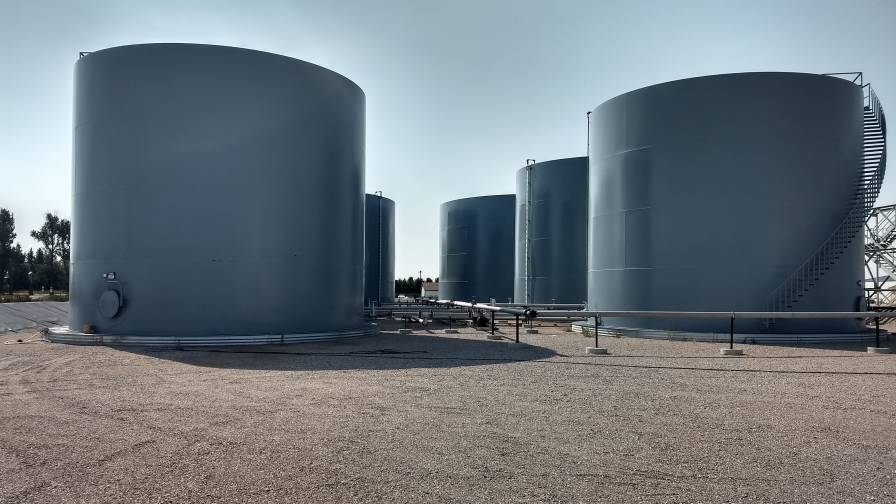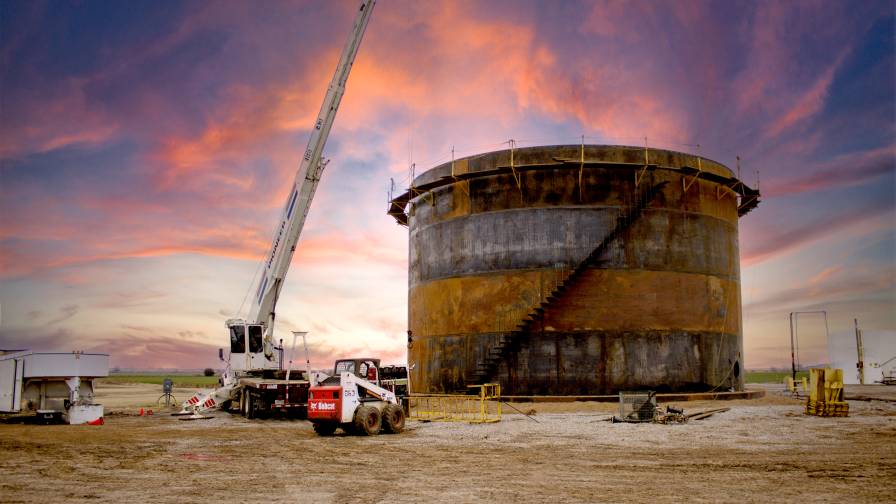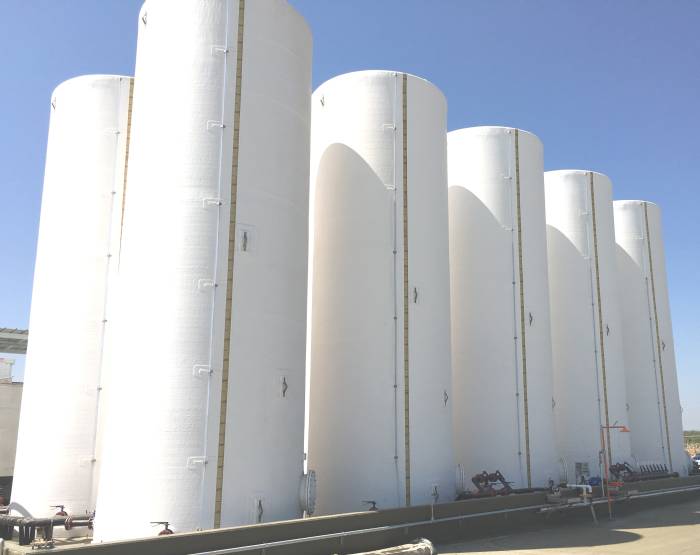Storage Tanks and Containment: How Manufacturers Are Adapting to Meet Customer Needs

Tank and containment manufacturers are optimistic about 2024 and beyond. Photo credit: Precision Tank
The tank and containment market in ag retail was mostly positive for manufacturers this year. And according to manufacturers, 2024 should be even better.
“Outstanding,” said David Hemming, President and CEO, Springfield, IL-based Precision Tank, when asked to characterize the past year’s market. “The last several years we have enjoyed strong demand for shop-built tanks, field-erected tanks, and piping.”
Maybe like in real estate it’s all about location. Nearly 600 miles to the southwest in Shawnee, OK, Agraliners shared a little less enthusiasm for 2023 sales.

The market for fertilizer tanks was strong the first half of the year, but slowed some in the third quarter, say some manufacturers. Photo credit: Agraliners
“It still seems flat; companies are being very cautious about purchasing new tanks,” says Dale Pedersen, Business Development Manager, Agraliners. “Companies seem to be more focused on protecting their assets rather than replacing them. This is possibly due to the price of steel and labor shortages.”
Todd Kringen, Outside Sales Representative, for Flandreau, SD-based J.C. Ramsdell Enviro Services, Inc. has seen a lot of positive in the market and the company has been able to serve those retailers not ready to erect new systems.
“Ag retail has always been in a continuous state of improving efficiency and product offering which leads to expansions, new facilities, and upgrades of older containment systems,” Kringen says. In addition, the company has benefited from a consistent secondary containment demand for the past several years, he added.
The team at Enviropac has seen both sides of the market.
“The market for fertilizer tanks has been strong the first half of the year and slowed some in the third quarter,” says Dennis Neal, President, Compton, IL-based Enviropac. “Dryer crop conditions and increased interest rates have played a factor in this reduction.”
Adapting to a Changing Market
As the industry evolves, so too do customers’ needs.
“We are seeing more multiple tank projects — two or more tanks to build at one location — greenfield locations that did not have existing structures or equipment,” says Brian Hasselbring, Regional Sales Project Manager at Oklahoma City, OK-based Heartland Tank Services. “In the past, it was mostly one tank at an existing working location.”

Manufacturers says customers are becoming more strategic when addressing their tank and containment needs. Photo credit: Heartland Tank
According to Paul Butler, Regional Sales Project Manager at Heartland, customers are making very careful decisions about when and where to have new storage installed.
“Our customers are continuing to review their storage needs and review the position in the market as it relates to their buyers,” Butler says. “Our clients are trying to strategically place new storage construction in regions they believe are untapped or provide them with a competitive advantage.”
According to Precision Tank’s Hemming, one particular type of tank has generated the most interest. “Our backlog on fiberglass tanks especially has become too long due to excellent demand,” he says. “We purchased another fiberglass tank mandrel to increase our capacity.”
Serving customers requires more than just delivering quality products. It also involves meeting their needs.

Enviropac introduced a Rent-to-Own program last year to help meet customer needs. Photo credit: Enviropac
“We introduced a special Rent-to-Own Program last year with good success,” Enviropac’s Neal says. “With the increase in interest rates, it is harder for the dealers to justify, however, with the opportunity to lock in tank costs and delivery, without large capital expenditures is still an opportunity for dealers.”
Another selling point says Pedersen: “Agraliners is the only company that can legitimately claim our materials are made only here in the U.S. We don’t see off price, but rather we sell off quality and experience.” And if you happen to attend the Midwest AG Industries Exposition, Pedersen claims, the company provides the best tacos and tamales.
“We are adding additional types of solutions for our customers and increasing the opportunity to educate people,” Pedersen continues. “We are all about education and relationships with our customers. Our owners have been in the business longer than anyone else offering liner systems, as a result you are getting experience and quality.”
Expectations
“Enviropac looks for a pick-up in the demand for 2024,” Neal says. “With the expanded product line from 5,000 to 50,000 gallons, dealers can have a one-source supplier for their tank requirements.”
Heartland’s Hasselbring expects fewer new tank construction projects and more repair work on existing liquid fertilizer storage tanks. In addition, he expects the company’s Leak Detection System to be more in demand. His colleague Butler expects storage for starter fertilizers, “such as ATS or 10-34-0 seems to be driving the demand for new tank storage construction.” Heartland Tank also claims to use only American made materials.
Like most sales opportunities, it’s about the relationship developed with the customer — whether that’s a retailer or the growers themselves.
“The health of our environment is almost a daily topic in news headlines and ag retailers are leading in helping to protect it,” says J.C. Ramsdell’s Kringen. “Sharing that message with and alongside growers is time well spent. Not all states have regulations for on-farm storage. There is room to engage growers who choose to store on-farm the value of secondary containment. The reasons are parallel to that of retail.”
And just like in retail, it’s about providing for end-users.
“For our company it would be continued growth and diversification to meet customers’ needs,” Pedersen says. Those same customers are “cautious commitment to how they are spending their dollars.”
Growth comes when the customers grow, too.
“Continued emphasis on larger facilities that deliver routinely out 30 or more miles radius,” Precision Tank’s Hemming says. “These large facilities utilize automation to the fullest. At MAGIE, a customer stated how seven semis were loaded at their facility within 20 minutes, with only one person working at the time.”
While sticker price is always an issue the total cost of ownership should also be considered.
“Our role at J.C. Ramsdell is to make containment systems dependable and easy to maintain,” Kringen says. “This is something that is echoed from ag retail operation and EHS staff. Our systems center around incorporating HDPP liners, which are known for their longevity and ease of upkeep. With the use of HDPP products there are no conversations about caulking cracked cement.
2024 & Beyond
“The future is bright,” Kringen continues. “For the most part we know that regulatory rules and guidance drive the containment industry. Secondary containment is much more than just ‘checking the box’ on a regulatory list. The industry needs to evaluate systems that have been in service well past their life expectancy.”
One challenging topic around containment systems is when to replace an older system and how to justify it. Is it through increased sales expectations or a function of lowering financial exposure of a failed system and clean-up costs? It is important to think back to the why of containment — it’s about protecting your inventory investment, mitigating environmental / financial risks of catastrophic spills and also those small ones that may occur over a lifetime at a facility.
Looking to next year and beyond, Kringen expects to see “continued storage upgrades at all sizes of retail. Continued public awareness of sustainable practices and environmental safety will strengthen retailers’ efforts to demonstrate and communicate their role on these topics.
“Similar to past years, centrally located hubs are commonplace,” Kringen says. “Non-field erected tanks are getting larger — 20,000- and 30,000-gallon tanks used to be standard, but are increasingly moving to 40,000, 50,000, and 60,000 (gallons).”
Heartland’s Butler echoed that sentiment.
“The main trend that we have seen from our customers over the past few years is the pursuit of larger storage tanks,” he says. “We have yet to hear back from one of our clients at the end of a construction project saying, ‘I wish a built a smaller tank.’”
Challenges
While they share optimism for the future of the tanks and containment segment in the coming years, manufacturers are realists, and they recognize there are a few challenges in the offing.
“When furnishing large shop-built tanks, freight continues to be major issue,” Enviropac’s Neal says. “Increased freight costs and uncertainty in the cost of fuel because of the lack of oil production is a challenge.”
Like many other areas of agriculture, tanks and containment systems face increasing governmental oversight, Pedersen says. There are “more regulations coming down from the states,” he says. “Some states have already tightened things up dramatically and other states are watching closely.”
Hemming says the industry — like most others — faces another difficult challenge: Labor.
“Finding and retaining great production people,” he says. “This issue seems to be nationwide. COVID and the aftermath seems to have reduced the number of people wanting to work.”
Whatever the challenges, manufacturers are bullish about the coming tanks and containment market.






